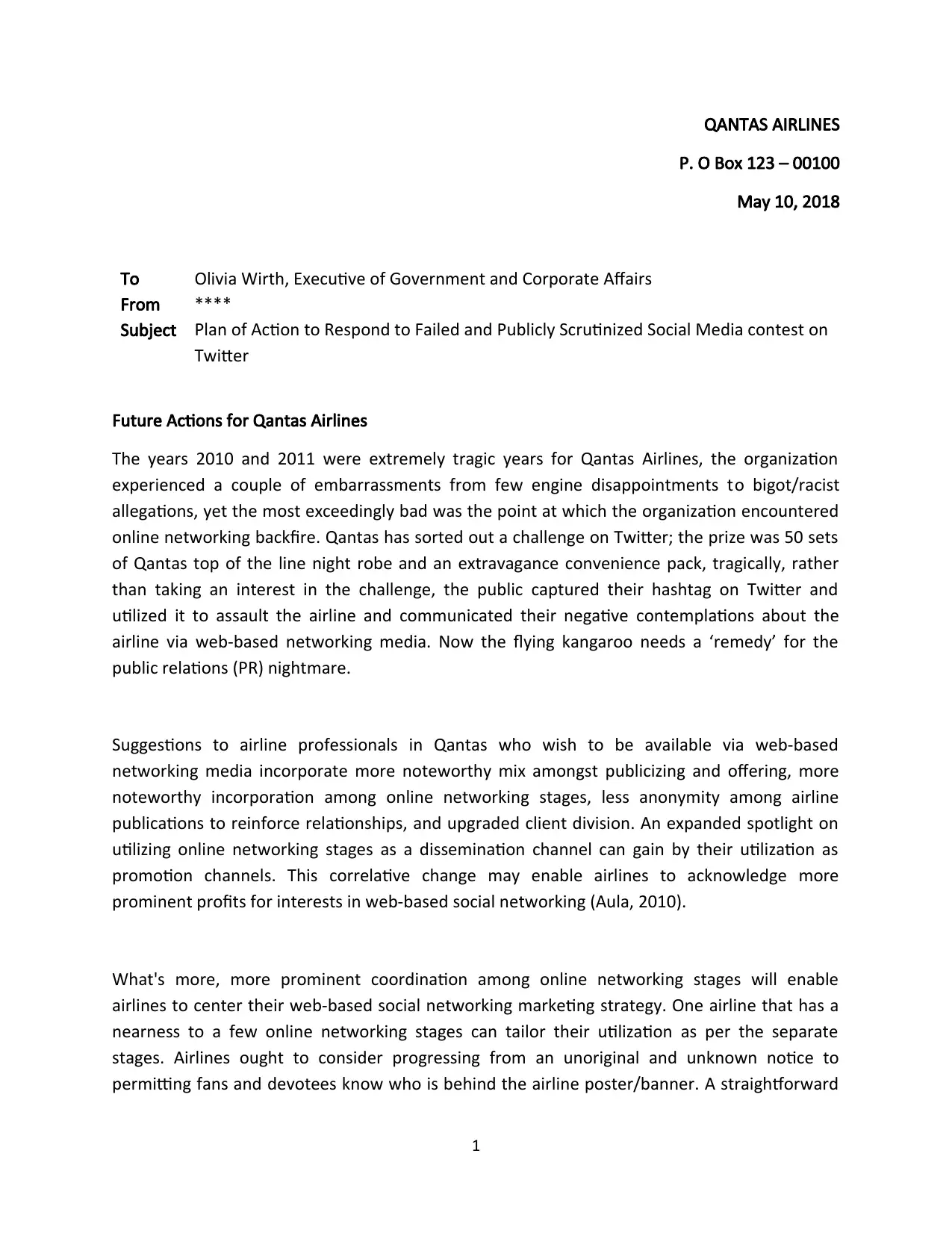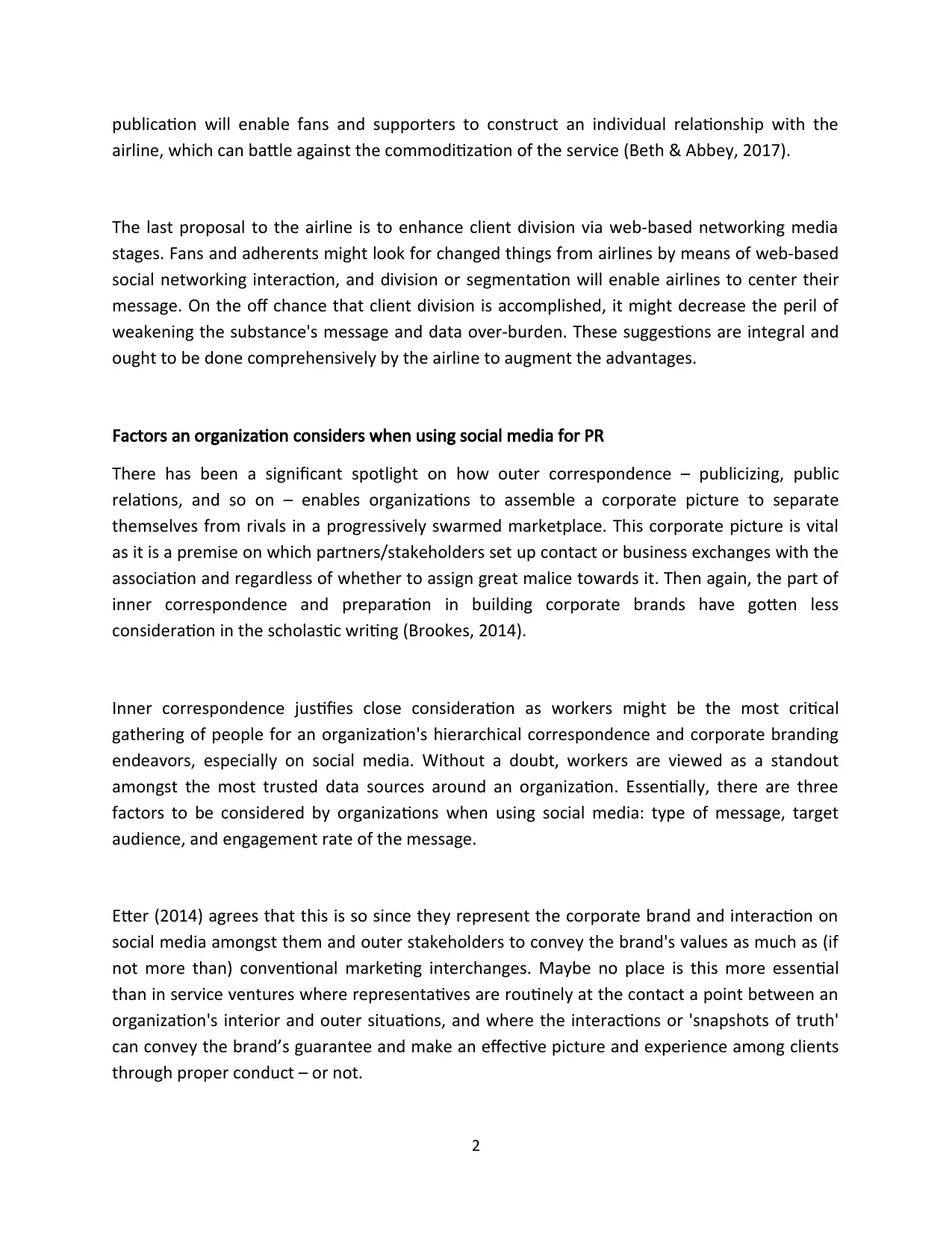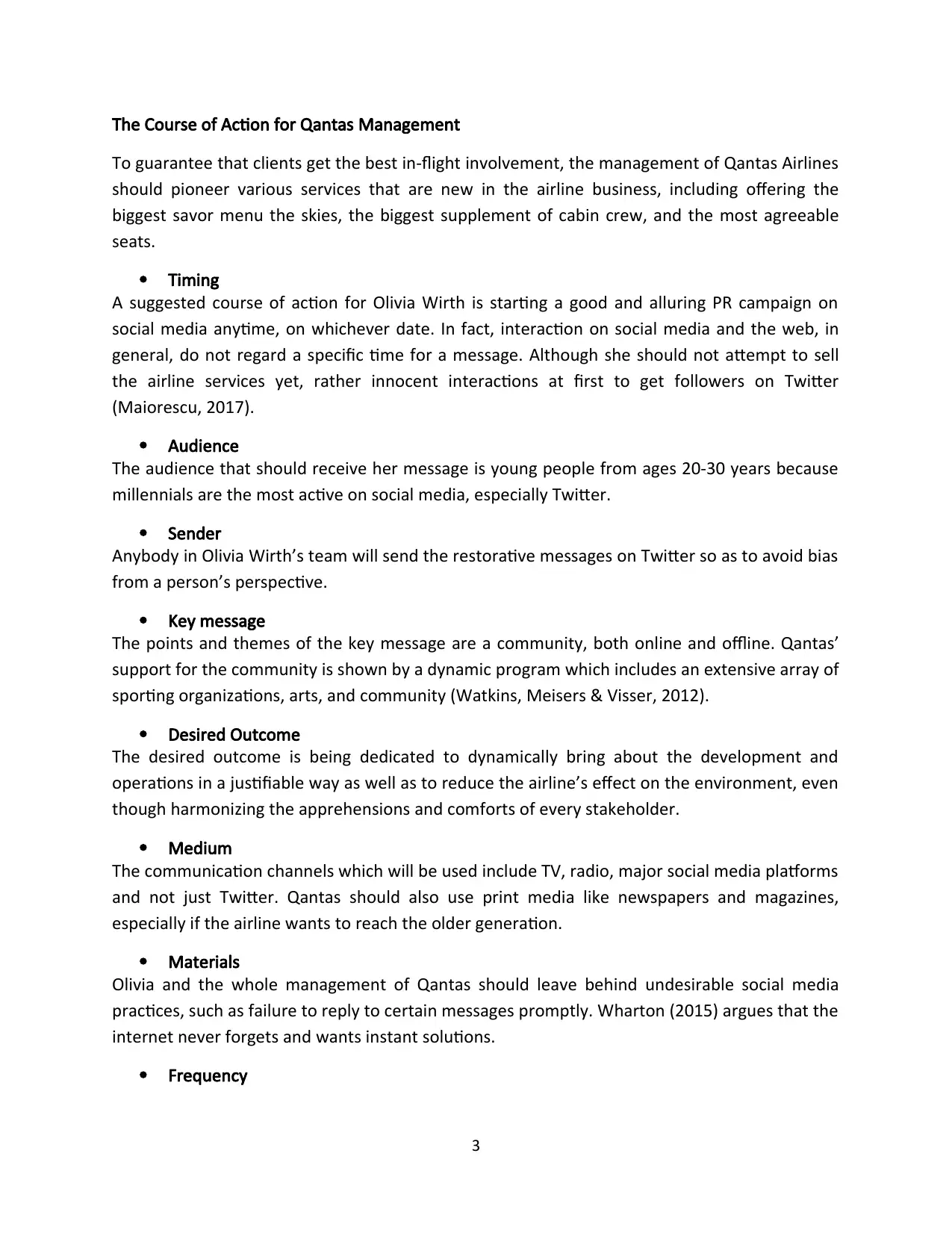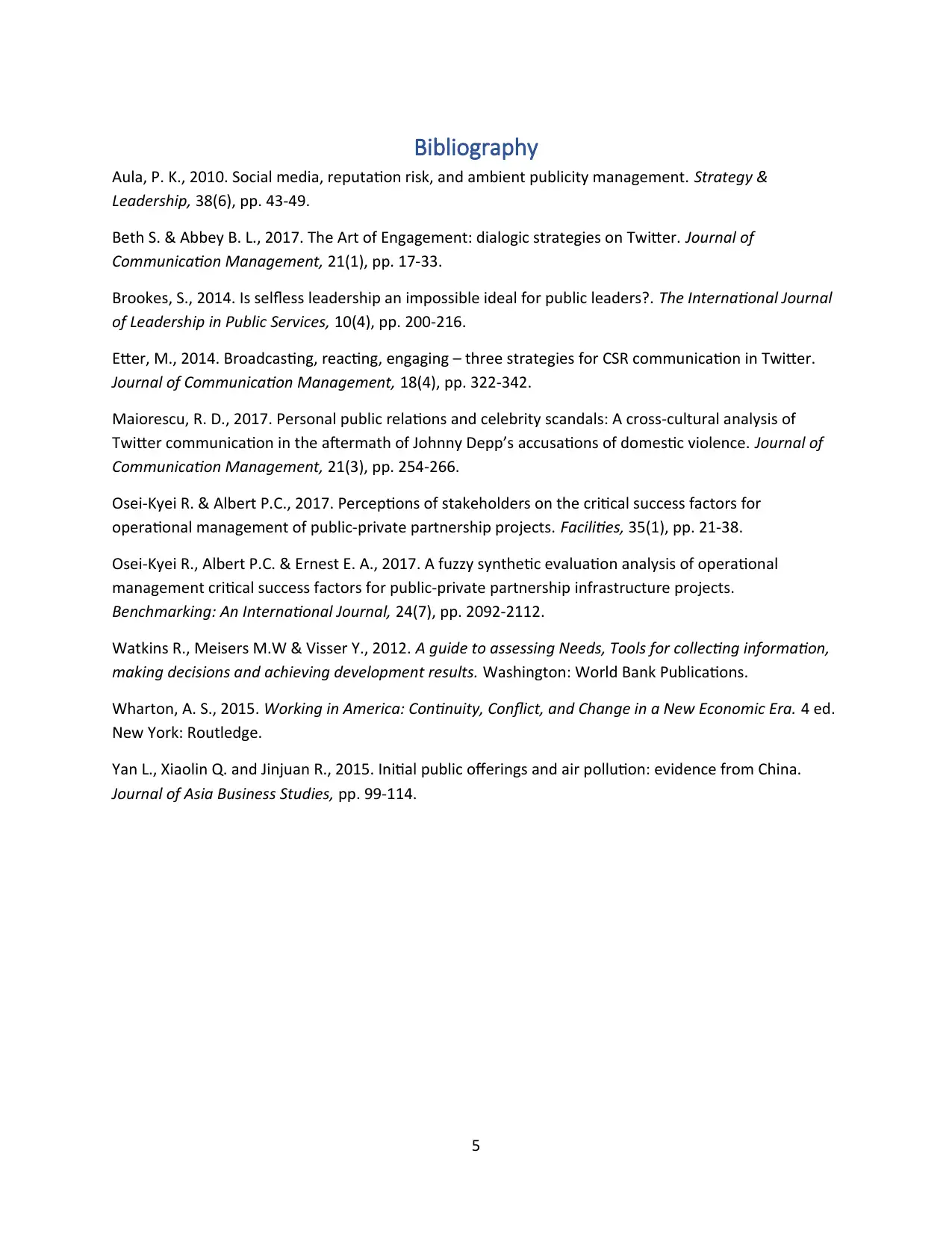Qantas Airlines: Plan of Action for Social Media Crisis Response
VerifiedAdded on 2021/05/30
|5
|1509
|28
Report
AI Summary
This report analyzes the 2010-2011 social media crisis faced by Qantas Airlines, triggered by a failed Twitter contest that led to public backlash. It outlines a plan of action for Qantas to improve its public relations and marketing strategies. The report recommends greater integration between advertising and social media platforms, increased transparency in airline publications to build relationships, and enhanced customer segmentation. It emphasizes the importance of considering message type, target audience, and engagement rates when using social media for PR. The proposed course of action involves launching an appealing PR campaign, targeting young audiences, and utilizing various communication channels. The report stresses the importance of timely responses and consistent engagement to manage the airline's reputation and reduce its environmental impact while harmonizing stakeholder concerns. The report concludes with a detailed bibliography of relevant academic sources.

QANTAS AIRLINES
P. O Box 123 – 00100
May 10, 2018
To Olivia Wirth, Executive of Government and Corporate Affairs
From ****
Subject Plan of Action to Respond to Failed and Publicly Scrutinized Social Media contest on
Twitter
Future Actions for Qantas Airlines
The years 2010 and 2011 were extremely tragic years for Qantas Airlines, the organization
experienced a couple of embarrassments from few engine disappointments to bigot/racist
allegations, yet the most exceedingly bad was the point at which the organization encountered
online networking backfire. Qantas has sorted out a challenge on Twitter; the prize was 50 sets
of Qantas top of the line night robe and an extravagance convenience pack, tragically, rather
than taking an interest in the challenge, the public captured their hashtag on Twitter and
utilized it to assault the airline and communicated their negative contemplations about the
airline via web-based networking media. Now the flying kangaroo needs a ‘remedy’ for the
public relations (PR) nightmare.
Suggestions to airline professionals in Qantas who wish to be available via web-based
networking media incorporate more noteworthy mix amongst publicizing and offering, more
noteworthy incorporation among online networking stages, less anonymity among airline
publications to reinforce relationships, and upgraded client division. An expanded spotlight on
utilizing online networking stages as a dissemination channel can gain by their utilization as
promotion channels. This correlative change may enable airlines to acknowledge more
prominent profits for interests in web-based social networking (Aula, 2010).
What's more, more prominent coordination among online networking stages will enable
airlines to center their web-based social networking marketing strategy. One airline that has a
nearness to a few online networking stages can tailor their utilization as per the separate
stages. Airlines ought to consider progressing from an unoriginal and unknown notice to
permitting fans and devotees know who is behind the airline poster/banner. A straightforward
1
P. O Box 123 – 00100
May 10, 2018
To Olivia Wirth, Executive of Government and Corporate Affairs
From ****
Subject Plan of Action to Respond to Failed and Publicly Scrutinized Social Media contest on
Future Actions for Qantas Airlines
The years 2010 and 2011 were extremely tragic years for Qantas Airlines, the organization
experienced a couple of embarrassments from few engine disappointments to bigot/racist
allegations, yet the most exceedingly bad was the point at which the organization encountered
online networking backfire. Qantas has sorted out a challenge on Twitter; the prize was 50 sets
of Qantas top of the line night robe and an extravagance convenience pack, tragically, rather
than taking an interest in the challenge, the public captured their hashtag on Twitter and
utilized it to assault the airline and communicated their negative contemplations about the
airline via web-based networking media. Now the flying kangaroo needs a ‘remedy’ for the
public relations (PR) nightmare.
Suggestions to airline professionals in Qantas who wish to be available via web-based
networking media incorporate more noteworthy mix amongst publicizing and offering, more
noteworthy incorporation among online networking stages, less anonymity among airline
publications to reinforce relationships, and upgraded client division. An expanded spotlight on
utilizing online networking stages as a dissemination channel can gain by their utilization as
promotion channels. This correlative change may enable airlines to acknowledge more
prominent profits for interests in web-based social networking (Aula, 2010).
What's more, more prominent coordination among online networking stages will enable
airlines to center their web-based social networking marketing strategy. One airline that has a
nearness to a few online networking stages can tailor their utilization as per the separate
stages. Airlines ought to consider progressing from an unoriginal and unknown notice to
permitting fans and devotees know who is behind the airline poster/banner. A straightforward
1
Paraphrase This Document
Need a fresh take? Get an instant paraphrase of this document with our AI Paraphraser

publication will enable fans and supporters to construct an individual relationship with the
airline, which can battle against the commoditization of the service (Beth & Abbey, 2017).
The last proposal to the airline is to enhance client division via web-based networking media
stages. Fans and adherents might look for changed things from airlines by means of web-based
social networking interaction, and division or segmentation will enable airlines to center their
message. On the off chance that client division is accomplished, it might decrease the peril of
weakening the substance's message and data over-burden. These suggestions are integral and
ought to be done comprehensively by the airline to augment the advantages.
Factors an organization considers when using social media for PR
There has been a significant spotlight on how outer correspondence – publicizing, public
relations, and so on – enables organizations to assemble a corporate picture to separate
themselves from rivals in a progressively swarmed marketplace. This corporate picture is vital
as it is a premise on which partners/stakeholders set up contact or business exchanges with the
association and regardless of whether to assign great malice towards it. Then again, the part of
inner correspondence and preparation in building corporate brands have gotten less
consideration in the scholastic writing (Brookes, 2014).
Inner correspondence justifies close consideration as workers might be the most critical
gathering of people for an organization's hierarchical correspondence and corporate branding
endeavors, especially on social media. Without a doubt, workers are viewed as a standout
amongst the most trusted data sources around an organization. Essentially, there are three
factors to be considered by organizations when using social media: type of message, target
audience, and engagement rate of the message.
Etter (2014) agrees that this is so since they represent the corporate brand and interaction on
social media amongst them and outer stakeholders to convey the brand's values as much as (if
not more than) conventional marketing interchanges. Maybe no place is this more essential
than in service ventures where representatives are routinely at the contact a point between an
organization's interior and outer situations, and where the interactions or 'snapshots of truth'
can convey the brand’s guarantee and make an effective picture and experience among clients
through proper conduct – or not.
2
airline, which can battle against the commoditization of the service (Beth & Abbey, 2017).
The last proposal to the airline is to enhance client division via web-based networking media
stages. Fans and adherents might look for changed things from airlines by means of web-based
social networking interaction, and division or segmentation will enable airlines to center their
message. On the off chance that client division is accomplished, it might decrease the peril of
weakening the substance's message and data over-burden. These suggestions are integral and
ought to be done comprehensively by the airline to augment the advantages.
Factors an organization considers when using social media for PR
There has been a significant spotlight on how outer correspondence – publicizing, public
relations, and so on – enables organizations to assemble a corporate picture to separate
themselves from rivals in a progressively swarmed marketplace. This corporate picture is vital
as it is a premise on which partners/stakeholders set up contact or business exchanges with the
association and regardless of whether to assign great malice towards it. Then again, the part of
inner correspondence and preparation in building corporate brands have gotten less
consideration in the scholastic writing (Brookes, 2014).
Inner correspondence justifies close consideration as workers might be the most critical
gathering of people for an organization's hierarchical correspondence and corporate branding
endeavors, especially on social media. Without a doubt, workers are viewed as a standout
amongst the most trusted data sources around an organization. Essentially, there are three
factors to be considered by organizations when using social media: type of message, target
audience, and engagement rate of the message.
Etter (2014) agrees that this is so since they represent the corporate brand and interaction on
social media amongst them and outer stakeholders to convey the brand's values as much as (if
not more than) conventional marketing interchanges. Maybe no place is this more essential
than in service ventures where representatives are routinely at the contact a point between an
organization's interior and outer situations, and where the interactions or 'snapshots of truth'
can convey the brand’s guarantee and make an effective picture and experience among clients
through proper conduct – or not.
2

The Course of Action for Qantas Management
To guarantee that clients get the best in-flight involvement, the management of Qantas Airlines
should pioneer various services that are new in the airline business, including offering the
biggest savor menu the skies, the biggest supplement of cabin crew, and the most agreeable
seats.
Timing
A suggested course of action for Olivia Wirth is starting a good and alluring PR campaign on
social media anytime, on whichever date. In fact, interaction on social media and the web, in
general, do not regard a specific time for a message. Although she should not attempt to sell
the airline services yet, rather innocent interactions at first to get followers on Twitter
(Maiorescu, 2017).
Audience
The audience that should receive her message is young people from ages 20-30 years because
millennials are the most active on social media, especially Twitter.
Sender
Anybody in Olivia Wirth’s team will send the restorative messages on Twitter so as to avoid bias
from a person’s perspective.
Key message
The points and themes of the key message are a community, both online and offline. Qantas’
support for the community is shown by a dynamic program which includes an extensive array of
sporting organizations, arts, and community (Watkins, Meisers & Visser, 2012).
Desired Outcome
The desired outcome is being dedicated to dynamically bring about the development and
operations in a justifiable way as well as to reduce the airline’s effect on the environment, even
though harmonizing the apprehensions and comforts of every stakeholder.
Medium
The communication channels which will be used include TV, radio, major social media platforms
and not just Twitter. Qantas should also use print media like newspapers and magazines,
especially if the airline wants to reach the older generation.
Materials
Olivia and the whole management of Qantas should leave behind undesirable social media
practices, such as failure to reply to certain messages promptly. Wharton (2015) argues that the
internet never forgets and wants instant solutions.
Frequency
3
To guarantee that clients get the best in-flight involvement, the management of Qantas Airlines
should pioneer various services that are new in the airline business, including offering the
biggest savor menu the skies, the biggest supplement of cabin crew, and the most agreeable
seats.
Timing
A suggested course of action for Olivia Wirth is starting a good and alluring PR campaign on
social media anytime, on whichever date. In fact, interaction on social media and the web, in
general, do not regard a specific time for a message. Although she should not attempt to sell
the airline services yet, rather innocent interactions at first to get followers on Twitter
(Maiorescu, 2017).
Audience
The audience that should receive her message is young people from ages 20-30 years because
millennials are the most active on social media, especially Twitter.
Sender
Anybody in Olivia Wirth’s team will send the restorative messages on Twitter so as to avoid bias
from a person’s perspective.
Key message
The points and themes of the key message are a community, both online and offline. Qantas’
support for the community is shown by a dynamic program which includes an extensive array of
sporting organizations, arts, and community (Watkins, Meisers & Visser, 2012).
Desired Outcome
The desired outcome is being dedicated to dynamically bring about the development and
operations in a justifiable way as well as to reduce the airline’s effect on the environment, even
though harmonizing the apprehensions and comforts of every stakeholder.
Medium
The communication channels which will be used include TV, radio, major social media platforms
and not just Twitter. Qantas should also use print media like newspapers and magazines,
especially if the airline wants to reach the older generation.
Materials
Olivia and the whole management of Qantas should leave behind undesirable social media
practices, such as failure to reply to certain messages promptly. Wharton (2015) argues that the
internet never forgets and wants instant solutions.
Frequency
3
⊘ This is a preview!⊘
Do you want full access?
Subscribe today to unlock all pages.

Trusted by 1+ million students worldwide

The airline can send new messages on Twitter three times a week, in the meantime replying to
comments and general interactions.
4
comments and general interactions.
4
Paraphrase This Document
Need a fresh take? Get an instant paraphrase of this document with our AI Paraphraser

Bibliography
Aula, P. K., 2010. Social media, reputation risk, and ambient publicity management. Strategy &
Leadership, 38(6), pp. 43-49.
Beth S. & Abbey B. L., 2017. The Art of Engagement: dialogic strategies on Twitter. Journal of
Communication Management, 21(1), pp. 17-33.
Brookes, S., 2014. Is selfless leadership an impossible ideal for public leaders?. The International Journal
of Leadership in Public Services, 10(4), pp. 200-216.
Etter, M., 2014. Broadcasting, reacting, engaging – three strategies for CSR communication in Twitter.
Journal of Communication Management, 18(4), pp. 322-342.
Maiorescu, R. D., 2017. Personal public relations and celebrity scandals: A cross-cultural analysis of
Twitter communication in the aftermath of Johnny Depp’s accusations of domestic violence. Journal of
Communication Management, 21(3), pp. 254-266.
Osei-Kyei R. & Albert P.C., 2017. Perceptions of stakeholders on the critical success factors for
operational management of public-private partnership projects. Facilities, 35(1), pp. 21-38.
Osei-Kyei R., Albert P.C. & Ernest E. A., 2017. A fuzzy synthetic evaluation analysis of operational
management critical success factors for public-private partnership infrastructure projects.
Benchmarking: An International Journal, 24(7), pp. 2092-2112.
Watkins R., Meisers M.W & Visser Y., 2012. A guide to assessing Needs, Tools for collecting information,
making decisions and achieving development results. Washington: World Bank Publications.
Wharton, A. S., 2015. Working in America: Continuity, Conflict, and Change in a New Economic Era. 4 ed.
New York: Routledge.
Yan L., Xiaolin Q. and Jinjuan R., 2015. Initial public offerings and air pollution: evidence from China.
Journal of Asia Business Studies, pp. 99-114.
5
Aula, P. K., 2010. Social media, reputation risk, and ambient publicity management. Strategy &
Leadership, 38(6), pp. 43-49.
Beth S. & Abbey B. L., 2017. The Art of Engagement: dialogic strategies on Twitter. Journal of
Communication Management, 21(1), pp. 17-33.
Brookes, S., 2014. Is selfless leadership an impossible ideal for public leaders?. The International Journal
of Leadership in Public Services, 10(4), pp. 200-216.
Etter, M., 2014. Broadcasting, reacting, engaging – three strategies for CSR communication in Twitter.
Journal of Communication Management, 18(4), pp. 322-342.
Maiorescu, R. D., 2017. Personal public relations and celebrity scandals: A cross-cultural analysis of
Twitter communication in the aftermath of Johnny Depp’s accusations of domestic violence. Journal of
Communication Management, 21(3), pp. 254-266.
Osei-Kyei R. & Albert P.C., 2017. Perceptions of stakeholders on the critical success factors for
operational management of public-private partnership projects. Facilities, 35(1), pp. 21-38.
Osei-Kyei R., Albert P.C. & Ernest E. A., 2017. A fuzzy synthetic evaluation analysis of operational
management critical success factors for public-private partnership infrastructure projects.
Benchmarking: An International Journal, 24(7), pp. 2092-2112.
Watkins R., Meisers M.W & Visser Y., 2012. A guide to assessing Needs, Tools for collecting information,
making decisions and achieving development results. Washington: World Bank Publications.
Wharton, A. S., 2015. Working in America: Continuity, Conflict, and Change in a New Economic Era. 4 ed.
New York: Routledge.
Yan L., Xiaolin Q. and Jinjuan R., 2015. Initial public offerings and air pollution: evidence from China.
Journal of Asia Business Studies, pp. 99-114.
5
1 out of 5
Related Documents
Your All-in-One AI-Powered Toolkit for Academic Success.
+13062052269
info@desklib.com
Available 24*7 on WhatsApp / Email
![[object Object]](/_next/static/media/star-bottom.7253800d.svg)
Unlock your academic potential
Copyright © 2020–2025 A2Z Services. All Rights Reserved. Developed and managed by ZUCOL.




